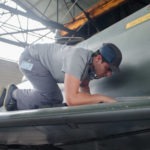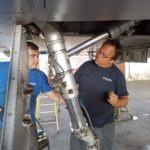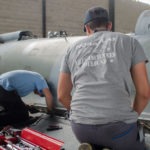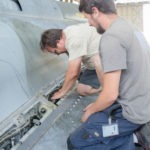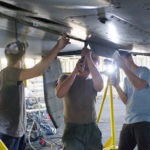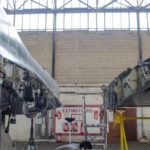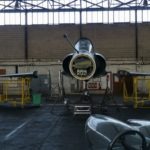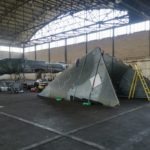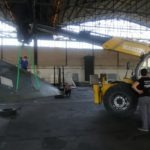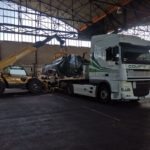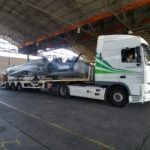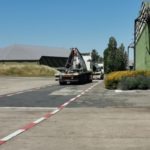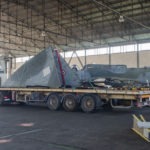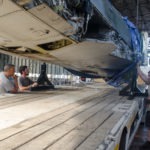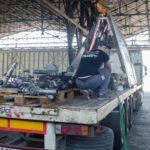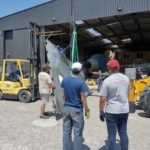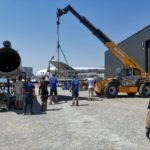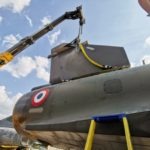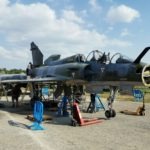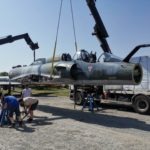
Le Mirage 2000N à la fin de son remonage à l’été 2019
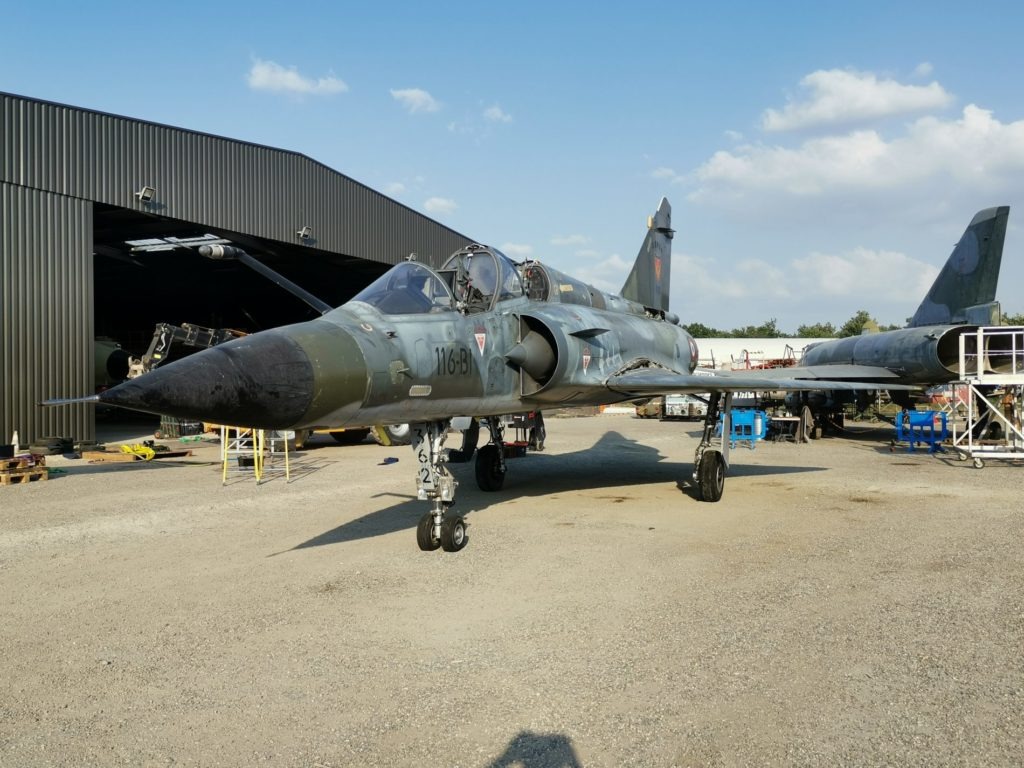
Le Mirage 2000N après son remontage
History
With the Mirage 2000, Dassault Aviation returns to the formula of delta-wing fighter jets (cf. the Mirage III, IV and 5). But the single-seater prototype that flew in 1978 benefits from the latest technologies in flight control (electric flight controls), fire control (Radar Doppler Multifunction then Impulse), and a more economical and more powerful engine Snecma M53-P2 (9.5 t thrust).
Delivered from 1984 to the French Air Force which will equip several squadrons, the 2000C version will be followed by the 2000B (two-seater for training), then the 2000-5 (interceptor) with an electronics allowing it to follow more than 20 targets simultaneously. In the air defence version, the Mirage 2000 could carry two Matra Super 530 air-to-air missiles and two Magic II for close combat. It now ships up to two MICA-EM and two MICA-IR missiles.
Two-seater versions will also be developed. The first, designated 2000N, is a two-seat strategic bomber (a pilot and a navigator officer) in charge of the all-weather nuclear strike at very low altitude with automatic terrain tracking, it then had a medium-range nuclear missile (ASMP then ASMPA). Deployed on bases in Luxeuil and Istres, three squadrons maintained the permanent nuclear alert from 1988 until 2018.
Finally, the 2000D, in service since 1993, is a conventional attack version derived from the 2000N. Two-seater (a pilot and a navigator-armament officer), it is capable of penetration at low altitude to deliver a whole range of armaments: laser guided bombs, air-ground missile ‘SCALP’, etc. He is still in service and has been regularly employed in external conflicts (Yugoslavia, Libya, Syria, Sahel-Saharan Strip.)
In total, the French Air Force will receive 314 Mirage 2000 in its various versions. In addition, nearly 300 copies will be delivered to eight different countries, many of which are still in service today: India, Qatar, Greece, etc.
Our aircraft
This is the Mirage 2000N N°336, a strategic nuclear attack bomber. It is one of the 74 Mirage 2000N that equipped the squadrons of the 4th Fighter Wing.He served with the prestigious 2/4 La Fayette, an heirloom unit of the WWI Squadron formed by American pilots who had pledged to fight alongside the Allies.
He was posted to us in 2019 by the Air Force. A team went to Châteaudun air base in July 2019 to disassemble the aircraft and load it on trucks. It was reassembled. Anyway canopies were missing during long month waiting the removal of the pyrotechnic system. They were reinstalled in April 2021.
It bears on the left side of the drift the insignia of the GERSA (Group of Maintenance of Repair and Storage of Aircraft), badge having never existed on the machines of the Air Force. This drift is not that of the 336, it was initially intended to be displayed in front of the GERSA, which is why it wears this insignia.
Characteristics
| Length | 14.9 m |
| Wingspan | 9.1 m |
| Height | 5.2 m |
| Crew: | 1 pilot et 1 weapon systems officer |
| Empty weight | 7.8 t |
| Maximum take off weight | 17.5 t |
| Top speed | Mach 1.4 |
| Range | 1480 km |
| Engine | 1 SNECMA M53-P2 of 9,5 t thrust of afterburner |
| Serial Number | 336 |
The retrieval of the aircraft
As is often the case with aircraft belonging to the French Air Force, the latter was on the EAR (Air Attached Element) 279 at Châteaudun. It is a team of 7 people who took charge of dismantling it.
This operation lasted barely 4 days which include disassembly in itself but also preparation for transport and loading on trucks.
Disassembly was facilitated by the fact that the aircraft was partially disassembled.

Notre Mirage 2000N lors de notre arrivée pour son démontage
The first step on this first day was to put the plane on candles: it is an important step since we will remove the landing gear later in order to remove the wings.
Then the disassembly itself begins with the disassembly of the Karman panels (the junction panels between the wing and the fuselage). Once this is done, it is the landing gear’s turn to be disassembled by a crew while a second is in charge of disconnecting all piping and cables between the wing and the fuselage.
- Nicolas qui déconnecte la tuyauterie à l’avant
- Nico et Maxime s’occupent de démonter les trains
- L’équipe au travail
- Les 2 Nico en rains de déconnecter les tuyaux et câbles
Another operation carried out: the removal of the 2 glass windows that still have their explosive cord used in case of ejection. These 2 elements will be kept by the Army until the disarmament takes place.
On the second day, while one crew continues to disconnect cables and hoses, another crew retracts the nosewheel into its housing.
Once the gear is retracted, we position the wing frames that will allow us to rest the wings during their removal.

Le Mirage 2000N prêt pour le démontage des ailes
With the aircraft ready, the disassembly of the wings will be carried out in 2 steps: first, the “secondary” axes at the front and rear of the wing are disassembled. Then it is the turn of the main axes. There are 4 axes per wing, which can be disassembled without the right tools.
With technique and patience, the 2 wings are finally disassembled!
- Démontage des axes en cours
- Démontage des axes en cours
- Démontage des axes en cours
- Démontage des axes en cours
- Le côté gauche après le retrait de l’aile
- Le Mirage après le retrait des 2 ailes
Day three was dedicated to preparation for transport: transfer of the wings on their transport frames and preparation of the fuselage.
- Le Mirage avec ses ailes sur bâti de transport
- Mise en place de l’aile sur bâti de transport
- Mise en place de l’aile sur bâti de transport
The fourth and final day will be dedicated to loading on trucks.
- Chargement du fuselage sur le camion
- Le fuselage est chargé et prêt à partir
- Fuselage chargé !
- Ailes Chargées
- Camions au départ !
- En route vers Toulouse
- Le convoi presque entièrement chargé
- Le fuselage est posé sur son bâti de transport
- Chargement du camion transport les ailes
On Saturday, back in Toulouse and thanks to all the volunteers, it is in one day that the device will be reassembled! All that will be missing is the reassembly of the Karmans and the glass windows when they are returned to us.
- Transport de l’aile
- On s’approche du fuselage avec l’aile
- Montage de la dérive
- Presque entièrement remonté
- Montage du radar
- L’avion entièrement remonté
- Le déchargement du fuselage
- Le déchargement du fuselage
- Le fuselage posé sur chandelle
The videos


